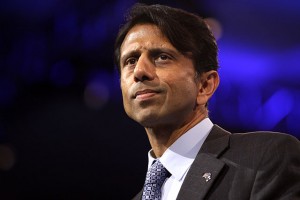Unfortunately, Bobby Jindal is no Bob Jones Both cried “religious freedom,” but there’s a big difference
A recent article in Slate compares Bobby Jindal, the conservative governor of Louisiana, to Bob Jones III, the fundamentalist and former president of Bob Jones University in South Carolina, pointing out that Jindal’s assertions of “religious freedom” as grounds for allowing discrimination against gays and lesbians are eerily similar to those Jones used over a decade ago in defending racial discrimination at his school. This makes for an interesting analogy, but also a dangerous one.
Bob Jones University prohibited interracial dating as recently as 2000, and Jones defended the discrimination based on his interpretation of biblical scripture, insisting that “religious freedom” gave the school the right to ignore discrimination law. Writing in Slate, William Saletan correctly notes that current arguments by Jindal, where he claims a right of religious exemption from laws prohibiting discrimination against gays and lesbians, are remarkably similar to the segregationist arguments of Jones. (In fact Jindal is not alone in making such claims, as some lawmakers in Kansas and many others have taken similar positions.)
As anyone who follows current events and legal trends knows, “religious freedom” is the cry that we increasingly hear from those who wish to have a personal veto power of sorts, based on their religious convictions, to avoid ordinary legal obligations. Pharmacists now claim “religious freedom” gives them the right to deny services to customers seeking contraception. Even corporations (such as Hobby Lobby, in resisting the birth control mandate of the Affordable Care Act) are making the claim.
In comparing Jindal to Jones, however, Saletan overlooks one critical point: Jones and his views were seen as fringe and quickly dismissed by the media and the vast majority of Americans, but Jindal and his views are taken much more seriously. Jones was a defiant religious leader running an isolated college in the South, and he was met with facepalms even from conservatives when he claimed religious freedom as a basis for racial discrimination. Jindal, meanwhile, is an Ivy-educated Rhodes Scholar, and he will almost certainly be a contender for the GOP presidential ticket, at the top or as vice president. The story here is not the similarity of the Jones and Jindal arguments, but the difference in their public receptions.
In fact, if there is any doubt that claims of “religious freedom” are taken seriously today as a basis for avoiding the law, look no further than the aforementioned case of Hobby Lobby, the company that is claiming “religious freedom” to avoid the contraception mandate of the Affordable Care Act. Not only is Hobby Lobby’s case heading to the Supreme Court, but it’s doing so with the company having won its case in the lower court using the “religious freedom” argument!
It’s bad enough that the religious right has completely shifted the playing field in the United States, but it’s even worse that the shift goes largely unnoticed. What was once fringe is now seen in the mainstream, and few seem to take notice. Jones was one of those fringe figures, but Jindal is not. Draw an analogy between the two if you wish, but don’t take it too far: It’s not inconceivable that Jindal could be taking an oath of office on January 20, 2017, and if it happens nobody will be confusing him for Bob Jones. (And those who think it’s inconceivable should bear in mind that many thought Reagan could never be elected either.)
With this in mind, seculars would be wise to consider how the “religious freedom” argument has risen in prominence. It started with passage of the Religious Freedom Restoration Act (RFRA) in 1994, a law that was pushed by the religious right and religious liberals alike with few realizing that it would give religion a new level of privilege in American public life. Under RFRA, generally speaking, any federal law or action that imposes on religion is subjected to strict scrutiny, meaning the imposing activity will usually be struck down. (Many states now have state RFRA statutes that apply to state laws as well.)
Importantly, this strict-scrutiny standard applies even to laws that were not passed for the purpose of imposing on religion. Before RFRA, if a law was “neutral and of general applicability,” it would be upheld even if it incidentally imposed on an individual’s religious beliefs or practices. See: Employment Division v. Smith, 494 U.S. 872 (1990). A law could be struck down if it was passed for the purpose of favoring (or disfavoring) a religion (see Church of Lukumi v. Hialeah, 508 U.S. 520 (1992)), but a truly neutral law – such as one setting forth the terms of health insurance coverage, for example, or prohibiting discrimination based on sexual orientation – would normally be upheld under the pre-RFRA standard.
Keeping in mind that RFRA was passed in 1994, when the Christian right was on the rise and the secular movement as we know it today was still a decade away, we can see how the playing field was being redefined in the absence of secular activism. Because of RFRA, religion now has such an exalted position in society that it can void laws that incidentally impose on it. This is far beyond the historical constitutional standard. (And keep in mind RFRA is just a statute – the constitutional standard of religious freedom under Smith, supra., has not changed.)
As such, if today’s seculars are considering long-term goals, one such goal surely must be to repeal RFRA. If that is ever going to happen, thereby returning religious freedom is its proper constitutional position, seculars must first build momentum through increased visibility and vocal demands for equality and fair treatment. By doing so, we will be in a better position to explain how RFRA is not about freedom at all, but privileging. When we reach that point as a movement, comparisons of Jindal to Jones will be much more valid.

